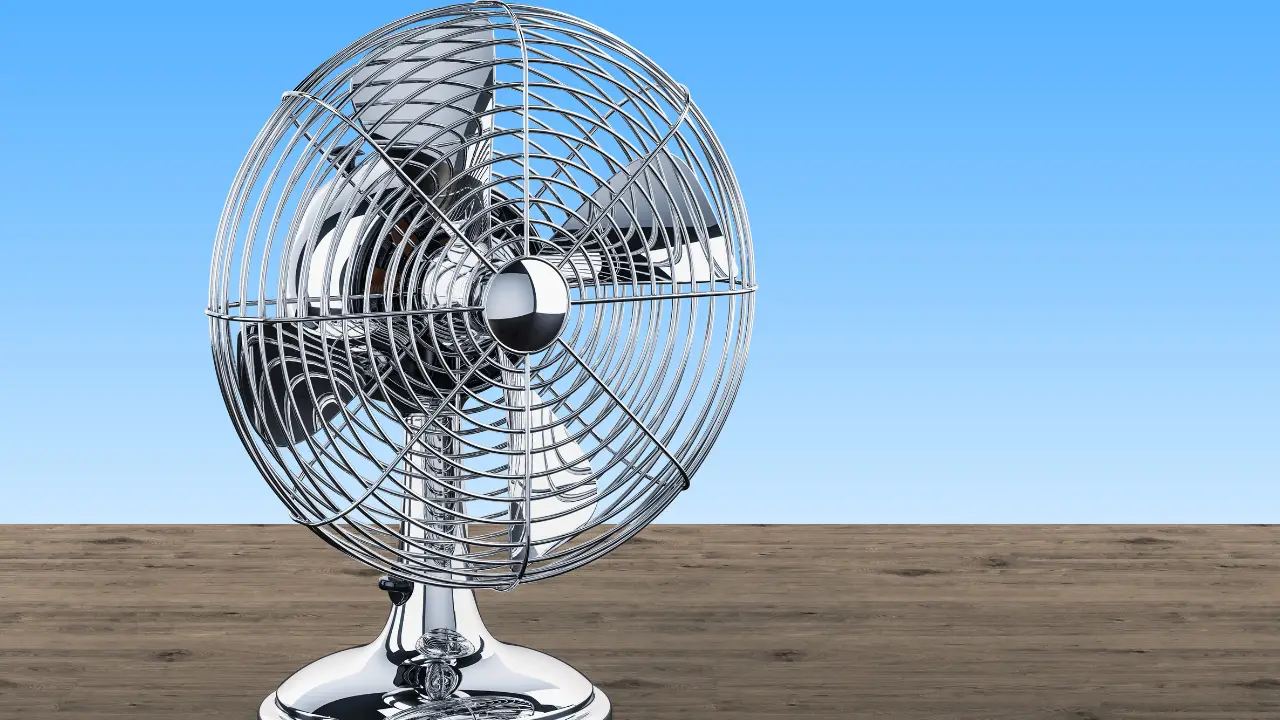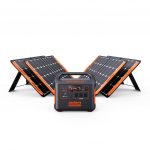The main component of a table fan is the blade. The blade is the rotating component that creates the airflow. Table fans can have single or multiple blades mounted on a central hub. The blade is typically made of plastic or metal and can have a variety of shapes and sizes. Some blades are designed to be more aerodynamic, which can help to increase the airflow while reducing noise.
The motor is another important component of a fan. The motor is responsible for turning the blade and creating the airflow. Either AC or DC electricity can power table fans. AC-powered fans are more common and are typically less expensive than DC-powered fans. However, DC-powered fans are more energy-efficient and can be quieter than AC-powered fans.
Table of Contents
Importance of choosing the right table fan
Choosing the right fan is important for several reasons. Here are some of the key reasons why selecting the right table fan is important:
Effective Cooling: The primary function of a fan is to provide cooling. Choosing the right fan that is appropriately sized and has the right features helps ensure effective cooling. If you choose a fan that is too small or doesn’t have enough power, it may not be able to cool your room effectively, leaving you uncomfortable and hot.
Energy Efficiency: Choosing an energy-efficient fan can help you save money on your electricity bills. Energy-efficient fans use less power and can still provide adequate cooling; This is important, especially if you plan to use your fan frequently or for long periods.
Noise Level: The noise level of a table fan is another important factor to consider. If you plan to use your fan in a bedroom or office, choose a quiet fan that doesn’t produce much noise; This can help you sleep or work more comfortably without being disturbed by the fan’s noise.
Durability: Choosing a fan that is well-built and durable can help ensure that it will last for a long time; This is especially important if you plan to use your fan frequently or in harsh conditions. A durable fan is less likely to break down or require repairs, saving you money in the long run.
Design and Style: Table fans come in various designs and styles, so choosing one that matches your preferences and fits in with your decor can be important. A well-designed and stylish fan can enhance the look of your room and add to its overall ambiance.
Types of Table Fans
Box fans
Box fans are a type of table fan with a square or rectangular shape. They are typically larger than other table fans. They can be more powerful, making them suitable for cooling larger rooms or areas.
Box fans typically have a simple design with a blade mounted on the front of the fan and enclosed by a metal or plastic housing. The housing usually has a carrying handle and feet or other supports that allow the fan to be placed on a flat surface, such as a table or floor.
Box fans usually have three-speed settings, which allow you to adjust the fan speed to your desired level of cooling. Some models may also have a reversible function, which allows you to change the airflow direction to either bring in fresh air or exhaust stale air.
Tower fans
Tower fans are another type of table fan with a tall, slender design designed to be placed on a flat surface, such as a table or floor. They typically have a vertical orientation and consist of a cylindrical base that houses the motor and controls and a tall, narrow tower that houses the fan blade and vents.
Tower fans usually have a more modern and sleek design than other table fans and can be more visually appealing. They often have a range of features, such as remote control, programmable timers, and multiple speed settings, which allow you to customize the fan’s operation to your preferences.
One of the advantages of tower fans is that they can be more effective at circulating air in larger rooms due to their tall, narrow design. They can also be relatively quiet compared to other fans, making them suitable for use in bedrooms and other quiet environments.
Tower fans may be more expensive than table fans due to their advanced features and design. However, they can be a good investment if you want an effective and visually appealing fan that can provide long-lasting cooling and ventilation for your home or office.
Pedestal fans
Pedestal fans are a type of table fan mounted on a stand and usually adjustable in height. The stand allows you to position the fan at different heights and angles, directing the airflow where you need it.
Pedestal fans usually have a circular fan blade enclosed by a protective grill. The fan blade is mounted on a vertical stand, supported by a round base. The base is usually weighted to stabilize and prevent the fan from tipping over.
Pedestal fans typically have multiple speed settings, which allow you to adjust the fan’s speed to your desired level of cooling. Some models may also have oscillating functions, allowing the fan to rotate back and forth, distributing cool air evenly throughout the room.
One of the advantages of pedestal fans is their versatility. The adjustable stand allows you to position the fan at different heights and angles, making it suitable for various settings. Pedestal fans can be used in homes, offices, workshops, and other environments where cooling and ventilation are needed.
Pedestal fans can be more powerful than other table fans due to their larger blade size and more robust motors; This makes them suitable for cooling larger rooms or areas.
However, pedestal fans can also be relatively bulky and may take up more space than other table fans. They may also be more expensive due to their more advanced features and larger size.
Factors to Consider When Choosing a Table Fan
Size and portability
Size: The size of a table fan is an important factor to consider when choosing the right fan for your needs. Table fans come in different sizes, ranging from compact desk fans to a larger pedestal or tower fans. The fan size you choose will depend on the room size or area you need to cool and your personal preferences. A smaller fan may be more suitable for a small bedroom or office, while a larger fan may be better for a living room or larger space.
Portability: Portability is also an important consideration when choosing a table fan. If you plan to move the fan around frequently or take it on the go, a portable fan would be a better choice. Desk fans are usually the most portable, as they are small and lightweight, making them easy to move from room to room or take with you on the go. Pedestal or tower fans can also be portable if they have wheels or other features that make them easy to move. However, larger fans may be more difficult to move around, so choosing a fan that fits your specific needs is important.
Noise level
Noise level is another important factor to consider when choosing a table fan. The noise level of a fan is measured in decibels (dB). It can significantly impact your comfort and well-being, especially if you plan to use the fan in a bedroom or other quiet space.
Some fans are quieter than others, so choosing a fan with a noise level that suits your needs is important. Look for fans with a low noise level rating, usually indicated on the fan’s packaging or product description.
A 50 dB or less noise level is considered quiet and should not disrupt your sleep or activities. Fans with a noise level of 60 dB or more may be too loud for some people, especially if you’re using the fan in a quiet environment.
Airflow power and speed
Airflow power, measured in cubic feet per minute (CFM), refers to the air the fan can move in a given amount of time. The higher the CFM rating, the more air the fan can move, which means it can cool a larger area more effectively. When choosing a table fan, consider the size of the room or space you need to cool, and choose a fan with an appropriate CFM rating.
Speed settings are another important factor to consider. Table fans usually come with multiple speed settings, which allow you to adjust the fan’s speed to your liking. Higher speed settings can provide a more powerful breeze and cool the room faster, while lower speed settings are quieter and more energy-efficient. Some fans also come with variable speed control, which allows you to adjust the fan’s speed more precisely.
Choosing a fan with a speed setting that suits your needs is important. For example, if you’re using the fan in a bedroom at night, you may want a low-speed setting that won’t disrupt your sleep. If you’re using the fan in a large living room during the day, you may want a higher speed setting to cool the room faster.
Oscillation and tilt
When choosing a table fan, oscillation and tilt are two additional factors to consider.
Oscillation refers to the ability of the fan to move back and forth, which helps to distribute the airflow more evenly around the room. Table fans can oscillate at different angles, ranging from 90 degrees to 360 degrees. Fans with a wider oscillation angle can cool a larger area more effectively, while fans with a narrower angle may be more suitable for smaller spaces.
Tilt is another factor to consider, which refers to the ability of the fan to tilt up or down, allowing you to direct the airflow where you need it most. Some fans have a fixed tilt angle, while others can be adjusted to different angles. Tilt is particularly useful for directing airflow towards a specific area or using the fan on a desk or table.
Energy efficiency
Energy efficiency is another important factor to consider when choosing a table fan. An energy-efficient fan can help you save money on electricity bills and reduce your carbon footprint.
One way to determine the energy efficiency of a table fan is to look for the Energy Star label. The Energy Star program is a government-backed initiative that promotes energy efficiency in consumer products. Fans with the Energy Star label meet strict energy efficiency guidelines the Environmental Protection Agency (EPA) set. They can help you save up to 60% on your energy bills compared to non-certified fans.
Another way to determine the energy efficiency of a fan is to look for the fan’s wattage rating. The wattage rating indicates how much power the fan uses to operate. Generally, the lower the wattage rating, the more energy-efficient the fan. Look for fans with a 60 watts or less wattage rating, which are typically more energy-efficient than higher-wattage fans.
Best Table Fans on the Market
Honeywell fan
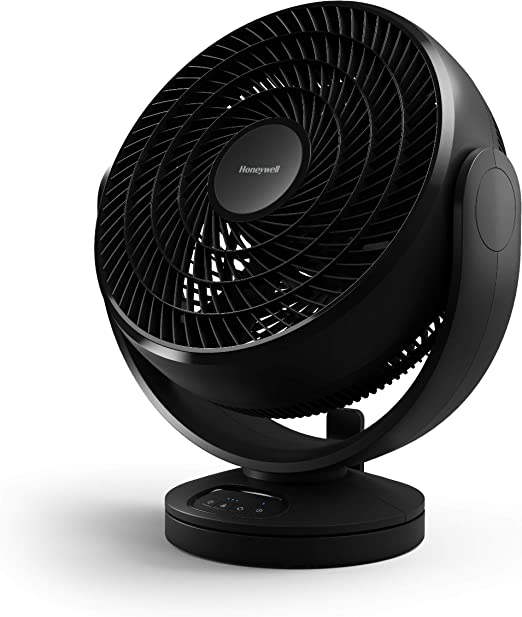
Honeywell is a popular brand offering a range of table fans, including tower, box, and desk fans. Honeywell fans are known for their reliability, durability, and high performance.
Honeywell tower fans are designed to provide powerful airflow in a compact design. They often come with features such as oscillation, multiple speed settings, and remote control. Honeywell box fans are also popular, offering a large blade diameter to move more air and providing a classic, retro look.
Honeywell desk fans are ideal for personal use, such as on a desk or nightstand. They are often small and can provide a quiet yet powerful breeze. Some Honeywell desk fans come with features such as tilt and oscillation, while others are designed to be compact and portable.
Dyson fan

Dyson is a well-known brand that offers a range of innovative and high-performance table fans. Dyson fans are known for their unique design, advanced technology, and quiet operation.
One of Dyson’s most popular fans is the Dyson Pure Cool Me. This fan features Dyson’s patented Air Multiplier technology, which creates a powerful stream of smooth airflow. The Pure Cool Me also includes a HEPA filter, which can capture 99.97% of allergens and pollutants in the air, making it an ideal choice for allergy sufferers.
Another popular Dyson table fan is the Dyson Pure Hot + Cool. This fan is designed to provide heating and cooling functions, making it suitable for use throughout the year. The Pure Hot + Cool features a HEPA filter to purify the air. It can oscillate up to 350 degrees to provide even airflow.
Dyson table fans are known for their unique and modern design, which can complement any home décor. They are also very quiet, making them ideal for use in bedrooms, living rooms, and other areas where noise can distract.
Vornado fan
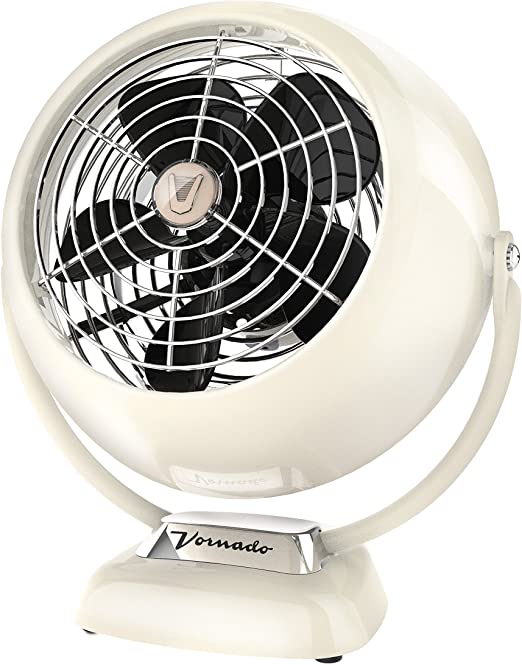
Vornado is a brand known for its high-performance air circulators, which include a range of table fans. Vornado table fans are designed to provide powerful and efficient airflow, making them ideal for homes and offices.
One of Vornado’s most popular fans is the Vornado 630 Mid-Size Air Circulator. This fan is designed to provide a powerful vortex of air, which can circulate the air in a room up to 70 feet away. The Vornado 630 features three-speed settings and a unique design that allows it to tilt and pivot, making it easy to direct the airflow where needed.
Another popular Vornado table fan is the Vornado 533 Compact Air Circulator. This fan is designed to provide a powerful and focused stream of air, making it ideal for use on a desk or tabletop. The Vornado 533 features three-speed settings and a compact, portable design, making it easy to move from room to room.
Vornado table fans are known for their energy efficiency, quiet operation, and durability. They are also easy to use and maintain, with many models featuring removable grills for easy cleaning.
Rowenta Fan
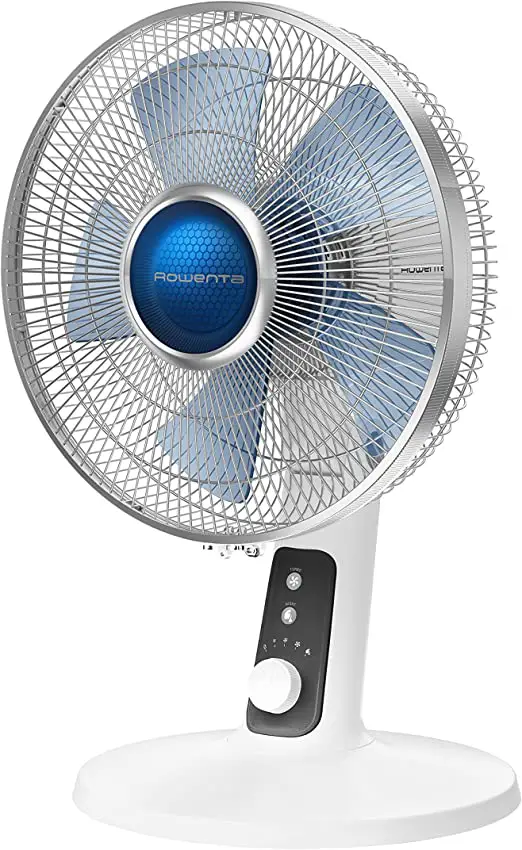
Rowenta is a popular brand that offers a range of high-performance table fans known for their powerful airflow, quiet operation, and sleek design. Rowenta table fans are designed to provide optimal air circulation, making them ideal for use in homes, offices, and other spaces.
One of Rowenta’s most popular table fans is the Rowenta Turbo Silence Extreme. This fan’s unique blade design allows it to provide powerful airflow while remaining quiet, even on its highest setting. The Turbo Silence Extreme also includes an oscillation feature, multiple speed settings, and a remote control for easy use.
Another popular Rowenta table fan is the Rowenta VU2630 Turbo Silence Table Fan. This fan is designed to provide a powerful and focused stream of air, making it ideal for use on a desk or tabletop. The Turbo Silence Table Fan features four-speed settings, a tilt and pivot feature, and a compact, portable design.
Rowenta table fans are known for their durability and long-lasting performance. They are also easy to use and maintain, with many models featuring removable grills for easy cleaning.
Westinghouse fans
Westinghouse is a well-known brand that offers various table fans designed to provide powerful and efficient airflow. Westinghouse table fans are available in different sizes, styles, and designs to suit different needs and preferences.
One of Westinghouse’s most popular table fans is the Westinghouse Lighting 7216100 Solana Two-Light 48-Inch Two-Blade Indoor Ceiling Fan. This fan is designed to provide optimal airflow while serving as a light fixture. The Solana Ceiling Fan features two blades and two light fixtures, including a remote control for easy operation.
Another popular Westinghouse table fan is the Westinghouse Lighting 7861400 Industrial 56-Inch Three-Blade Indoor Ceiling Fan. This fan is designed for industrial settings, with a powerful motor and three blades that can provide optimal airflow in large spaces. The Industrial Ceiling Fan also includes a pull chain for easy operation.
Westinghouse table fans are known for their durability, quiet operation, and energy efficiency. They are also easy to install and maintain, with many models featuring removable grills for easy cleaning.
Pelonis fan
Pelonis is a well-known brand that offers a range of table fans designed to provide optimal air circulation and cooling. Pelonis table fans are available in different sizes and styles to suit different needs and preferences.
One of Pelonis’s most popular table fans is the Pelonis 16-Inch DC Motor Pedestal Fan. This fan features a powerful DC motor that provides efficient and quiet operation and adjustable height and tilt settings for optimal airflow direction. The Pelonis pedestal fan also includes multiple speed settings and a remote control for easy operation.
Another popular Pelonis table fan is the Pelonis 12-Inch Oscillating Table Fan. This fan is designed to provide powerful airflow in a compact, portable package. The Pelonis table fan features adjustable speed settings, oscillation for wider air circulation, and a removable grill for easy cleaning.
Pelonis table fans are known for their energy efficiency, durability, and quiet operation. They are also easy to use and maintain, with many models featuring intuitive controls and removable grills for easy cleaning.
Hunter fan
Hunter is a well-known brand that offers a range of table fans designed to provide optimal air circulation and cooling. Hunter table fans are available in different sizes and styles to suit different needs and preferences.
One of Hunter’s most popular table fans is the Hunter 90438 16-Inch RETRO Stand Fan with Brushed Nickel Finish. This fan features a classic and stylish design with a brushed nickel finish and adjustable height and tilt settings for optimal airflow direction. The Hunter RETRO Stand Fan includes three-speed settings and oscillation for wider air circulation.
Another popular Hunter table fan is the Hunter 90406 12-Inch Portable Table Fan. This fan is designed to provide powerful airflow in a compact, portable package. The Hunter Portable Table Fan features a durable metal construction, adjustable speed settings, and a pivoting head for directional airflow.
Hunter fans are known for their durability, quiet operation, and energy efficiency. They are also easy to use and maintain, with many models featuring intuitive controls and removable grills for easy cleaning.
Air king fan
Air King is a popular brand that offers a range of fans designed to provide efficient and effective cooling. Air King table fans are available in different sizes and styles to suit different needs and preferences.
One of Air King’s most popular fans is the Air King 16-Inch Oscillating Table Fan. This fan’s powerful motor provides high-performance cooling, adjustable speed settings and oscillation for wider air circulation. The Air King Oscillating Fan also includes a durable metal construction and a pivoting head for directional airflow.
Another popular Air King table fan is the Air King 12-Inch Bladeless Table Fan. This fan is designed to provide powerful, quiet airflow in a unique and stylish package. The Air King Bladeless Fan features a bladeless design for safer operation, adjustable speed settings, and a compact and portable design.
Air King fans are known for their durability, efficiency, and reliability. They are also easy to use and maintain, with many models featuring intuitive controls and removable grills for easy cleaning.
Comfort zone fan
Comfort Zone is a popular brand that offers a range of table fans designed to provide efficient and effective cooling. Comfort Zone table fans are available in different sizes and styles to suit different needs and preferences.
One of Comfort Zone’s most popular fans is the Comfort Zone 6-Inch 2-Speed Adjustable Tilt Metal Table Fan. This fan features a durable metal construction and a compact and portable design, making it easy to move from room to room. The Comfort Zone Metal Table Fan also includes two-speed settings and adjustable tilt for optimal airflow direction.
Another popular Comfort Zone table fan is the Comfort Zone 9-Inch High-Velocity 3-Speed Table Fan. This fan is designed to provide powerful and efficient cooling in a compact, sturdy package. The Comfort Zone High-Velocity Table Fan features a durable metal construction, three-speed settings, and a pivoting head for directional airflow.
Comfort Zone fans are known for their durability, efficiency, and affordability. They are also easy to use and maintain, with many models featuring intuitive controls and removable grills for easy cleaning.
Geek aire fan
Geek Aire is a brand that offers a range of fans designed to provide efficient and effective cooling. Geek Aire table fans are available in different sizes and styles to suit different needs and preferences.
One of Geek Aire’s most popular fans is the Geek Aire 10-Inch Cordless Rechargeable Table Fan. This fan is cordless and rechargeable, making it easy to use anywhere without needing an outlet. The Geek Aire Rechargeable Table Fan also includes:
- Adjustable speed settings.
- Oscillation for wider air circulation.
- A built-in handle for easy portability.
Another popular Geek Aire fan is the Geek Aire 12-Inch Metal Table Fan. This fan is designed to provide powerful and efficient cooling in a stylish and durable metal package. The Geek Aire, Metal Table Fan, features three-speed settings, oscillation for wider air circulation, and adjustable tilt for optimal airflow direction.
Geek Aire table fans are known for their innovative designs, durability, and efficiency. They are also easy to use and maintain, with many models featuring intuitive controls and removable grills for easy cleaning.
How to Clean and Maintain Your Table Fan
Cleaning the blades and grills
Cleaning the blades and grills of your fan is important to maintain its efficiency and prevent dust and dirt buildup, which can affect the quality of the air it circulates. Here are the steps to clean the blades and grills of your table fan:
Turn off and unplug the fan: Always unplug the fan before cleaning it to avoid the risk of electric shock.
Remove the grill: Most fans have removable grills that can be easily removed by unscrewing or snapping. Check the user manual for instructions on how to remove the grill.
Soak the grill: Fill a sink or basin with warm, soapy water and soak the grill for a few minutes to loosen any dirt or debris. Use a soft-bristled brush or sponge to scrub the grill, especially around the blades, gently.
Clean the blades: Use a soft-bristled brush or a microfiber cloth to gently wipe down the blades, removing any accumulated dust or debris on them.
Dry the parts: Once you have finished cleaning the grill and blades, rinse them thoroughly with clean water and dry them with a clean cloth or let them air dry completely before reassembling the fan.
Reassemble the fan: Put the grill back and secure it with the screws or snaps.
Regular cleaning of your fan blades and grills can help maintain their performance and prolong their lifespan. It is recommended to clean the fan blades and grills at least once every few weeks or as needed, depending on the dust and debris in your environment.
Lubricating the motor
To lubricate the motor of your fan, you will need a high-quality lubricant oil, a soft cloth, and a screwdriver if necessary. Here are the steps to lubricate the motor:
Turn off and unplug the fan: Always ensure it is turned off and unplugged before working on it.
Remove the grill: Most fans have a removable grill that can be easily removed by unscrewing or snapping. Check the user manual for instructions on how to remove the grill.
Locate the motor: Once you have removed the grill, locate the motor. It is usually located in the center of the fan.
Clean the motor: Use a soft cloth to gently clean the motor and remove any dust or debris that may have accumulated on the motor or fan blades.
Lubricate the motor: Apply a small amount of high-quality lubricant oil to the motor shaft. The motor shaft is the part that rotates and is located in the center of the motor. Be sure not to over-lubricate, as this can cause excess oil to drip onto other parts of the fan and cause damage.
Spin the blades: Spin the blades by hand to distribute the oil evenly after lubricating the motor.
Replace the grill: Once you have finished lubricating the motor, replace the grill and screw it back into place.
Test the fan: Finally, plug in the fan and turn it on to test whether it runs smoothly and quietly. If you notice any unusual noise or vibration, turn off the fan and check the motor shaft to ensure the excess oil has been wiped off.
Replacing the filter
Table fans usually do not have air filters. However, if your fan has a filter. In that case, you must replace it periodically to ensure the fan continues circulating clean air. Here are the steps to replace the filter:
Locate the filter: Check the user manual for instructions on locating the filter. The filter is usually located behind the grill at the back of the fan.
Remove the grill: Most table fans have a removable grill that can be easily removed by unscrewing or snapping.
Remove the old filter: Carefully remove the old filter from the fan and dispose of it properly.
Install the new filter: Install the new filter by carefully inserting it into the filter slot. Make sure that the filter is properly aligned and securely in place.
Replace the grill: Once you have replaced the filter, replace the grill and screw it back into place.
Test the fan: Finally, plug in the fan and turn it on to test whether it runs smoothly and quietly.
Storing the fan
Properly storing your fan is important to ensure it is in good working condition when you need it again. Here are some tips for storing your fan:
Clean the fan: Before storing your fan, clean it thoroughly. Wipe down the fan’s blades, grills, and body with a damp cloth to remove any dust or dirt that may have accumulated.
Disassemble the fan: Disassemble the fan to make it easier to store. Remove the grill and blades and pack them separately.
Choose a dry, cool location: Choose a dry, cool location to store your fan. Avoid storing it in a humid or damp location, as this can cause rust or damage to the fan.
Use a cover: Consider using a cover to protect your fan from dust and other debris while in storage.
Store the fan upright: Store the fan upright to prevent damage to the blades and motor. If you need to store the fan on its side, make sure to secure the blades with tape or a tie to prevent them from moving around.
Check on the fan periodically: Check it periodically while it is in storage to ensure that it is not damaged or malfunctioning.
Tips for Using Your Table Fan
Proper placement
Proper placement of your fan is important to ensure that it operates effectively and efficiently. Here are some tips for placing your fan:
Keep it away from obstructions: Place your fan where walls, furniture, or other objects do not obstruct it. Obstructions can reduce the airflow and decrease the effectiveness of the fan.
Position it correctly: Position your fan to face the area where you want to feel the airflow. For example, if you want to cool down a room, position the fan so that it is blowing in the direction of the room.
Please keep it on a stable surface: Place your fan on a stable surface, such as a table or desk, to prevent it from falling or tipping over.
Avoid placing it near heat sources: Avoid placing your fan near heat sources, such as radiators, ovens, or heaters. Heat sources can cause the fan to malfunction and may even cause a fire.
Consider noise levels: If noise is a concern, place your fan on a soft surface, such as a carpet or rug, to reduce the noise level.
Keep it out of reach of children: If you have children, place your fan out of reach to prevent accidents or injuries.
Adjusting the settings
Adjusting the settings on your fan is important to customize your airflow to your liking. Here are some tips for adjusting the settings on your fan:
Speed settings: Most fans come with different speed settings, ranging from low to high. You can adjust the speed setting based on your preference and the temperature in the room. If you need more cooling, increase the speed setting; if you need less cooling, decrease the speed setting.
Oscillation: Many fans have an oscillation feature that allows the fan to rotate back and forth, distributing the airflow throughout the room. You can adjust the oscillation feature based on the size of the room and your personal preference.
Tilt: Some fans come with a tilting feature that allows you to adjust the direction of the airflow. You can tilt the fan upwards to cool the ceiling or downwards to cool the room.
Timer: Some fans come with a timer feature that allows you to set the fan to run for a certain amount of time and then turn it off automatically; This is useful if you want to cool down a room before going to bed and don’t want the fan to run all night.
Remote control: Many fans come with a remote control that allows you to adjust the settings from a distance; This is useful if you don’t want to get up from your seat or bed to adjust the fan.
Safety precautions
Here are some safety precautions to keep in mind when using a table fan:
Keep the fan out of reach of children and pets. Children and pets may be curious and may accidentally injure themselves or damage the fan.
Please do not touch the fan while it is in operation. The blades can cause injury if they come into contact with your skin.
Keep the fan away from water and other liquids. Do not operate the fan in a damp environment.
Do not place the fan near flammable materials. Keep the fan away from curtains, papers, and other materials that can easily catch fire.
Do not attempt to repair the fan yourself. If the fan is damaged, take it to a qualified repair person.
Always use the fan on a stable, level surface. Please do not place the fan on an unstable surface where it could fall or tip over.
Do not block the air intake or outlet of the fan. This can cause the fan to overheat and damage the motor.
Unplug the fan when not in use. This will prevent it from accidentally turning on and causing a fire or other damage.
Conclusion
Table fans are an affordable and effective way to cool down a room, improve air circulation, and create a comfortable environment. When choosing a table fan, it is important to consider factors such as size, portability, noise level, airflow power and speed, oscillation and tilt, energy efficiency, and brand reputation.
Many reliable and reputable brands in the market offer high-quality fans, such as Honeywell, Dyson, Vornado, Rowenta, Westinghouse, Pelonis, Hunter, Air King, and Comfort Zone. These brands offer a wide range of table fans with different features, styles, and price points to suit different needs and preferences.
To ensure your table fan operates efficiently and lasts for a long time, it is important to maintain it properly by cleaning the blades and grills, lubricating the motor, replacing the filter, storing it properly, and following safety precautions.

